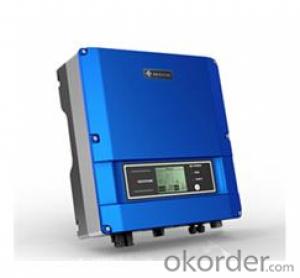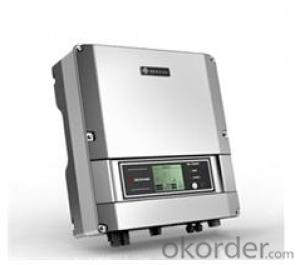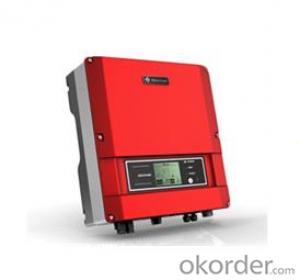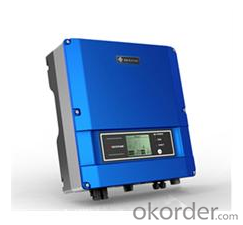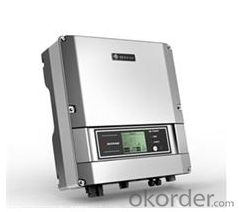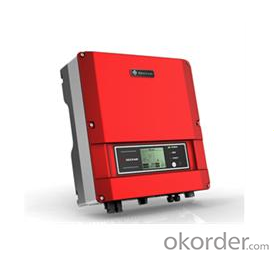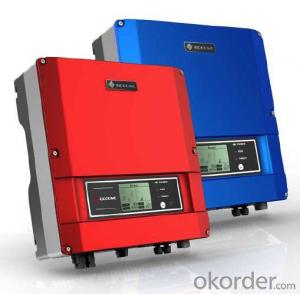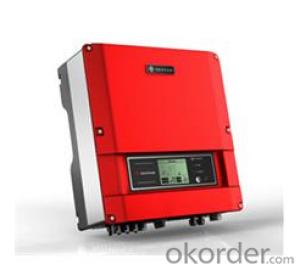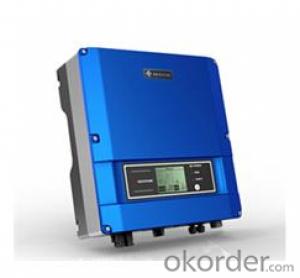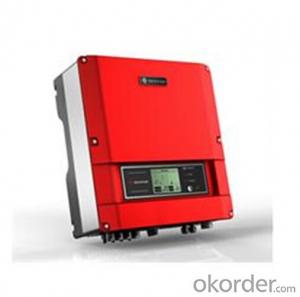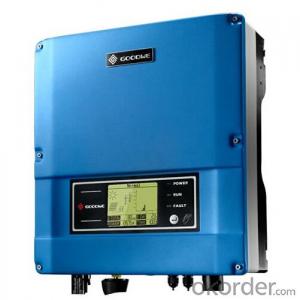Hybrid Solar Inverter GS3600S-UK
- Loading Port:
- Shanghai
- Payment Terms:
- TT OR LC
- Min Order Qty:
- 10 unit
- Supply Capability:
- 100 unit/month
OKorder Service Pledge
Quality Product, Order Online Tracking, Timely Delivery
OKorder Financial Service
Credit Rating, Credit Services, Credit Purchasing
You Might Also Like
GW3600S-UK
The SS series is widely and flexibly used in domestic units because of its wide range of voltage and current inputs. It features very high conversion efficiency and reliability. SS series provides long-term and stable generating benefits. The powerful, intelligent, user friendly interface and sleek stylish design make it most suitable for domestic applications.
| DC Input Data | Max.PV-generator power[W] | 4200 |
| Max.DC voltage[V] | 580 | |
| MPPT voltage range[V] | 125~550 | |
| Turn on DC voltage[V] | 125 | |
Max.DC work current[A] | 20 | |
| Number of inputs/MPP trackers | 3/1 | |
| DC connector | MC IV Connector | |
| Self-energy consumption[W] | <5< td=""> | |
| AC Output Data | Nominal AC power[W] | 3600 |
| Max.AC power[W] | 4000 | |
| Max.output current[A] | 16 | |
| Nominal output voltage range | G83/1; VDE0126-1-1/AI | |
| AC grid frequency | G83/1; VDE0126-1-1/A1 | |
| THDi | 〈1% | |
| Power factor | ~1 | |
| AC connection | Single phase with clamps | |
| Efficiency | Max.efficiency | 97.6% |
| European efficiency | >97.4% | |
| MPPT adaptation efficiency | >99.5% | |
| Safty Equipment | Leakage current monitoring unit | Integrated |
| DC switch disconnector | Optional | |
| Islanding protection | AFD | |
| Grid monitoring | G83/1; VDE0126-1-1/A1 | |
| Normative Reference | EMC compliance | EN 61000-6-1,EN 61000-6-2, EN 61000-6-3,EN 61000-6-4 |
| Safety compliance | According to IEC 62109-1 | |
| General Data | Dimensions(W*H*D) [mm] | 390*417*142 |
| Net weight [kg] | 18 | |
| Housing | For outdoor and indoor | |
| Mounting information | Wall bracket | |
| Operating temperature range | -20~60℃(up 45℃ derating) | |
| Relative humidity | 0 ~ 95% | |
| Site altitude[m] | 2000 | |
| IP proection class | IP65 | |
| Topology | Transformerless | |
| Cooling | Nature convection | |
| Noise level[dB] | 〈25 | |
| Display | 4" LCD | |
| Communication | USB2.0;RS485(Wireless/Bluetooth optional) | |
| Standard warranty[years] | 5/10/15/20/25 (optional) |
- Q: Can a solar inverter be used with different types of backup power configurations?
- Yes, a solar inverter can be used with different types of backup power configurations. Solar inverters are designed to convert the DC power generated by solar panels into AC power that can be used in homes or businesses. They can be used with backup power systems such as battery banks, diesel generators, or grid-tied systems with net metering. The inverter's ability to synchronize with different backup power sources allows for efficient and reliable energy supply in various configurations.
- Q: What are the common maintenance requirements for a solar inverter?
- Common maintenance requirements for a solar inverter typically include regular cleaning to remove dust and debris, checking and tightening electrical connections, inspecting for any signs of damage or wear, monitoring performance and output, and updating software or firmware as needed. Additionally, it is important to follow the manufacturer's guidelines and recommendations for maintenance to ensure optimal functionality and longevity of the solar inverter.
- Q: What is the role of a grid-tie inverter in a solar PV system?
- The role of a grid-tie inverter in a solar PV system is to convert the direct current (DC) electricity generated by the solar panels into alternating current (AC) electricity that can be fed directly into the electrical grid. It synchronizes the electricity produced by the solar panels with the grid's frequency and voltage, allowing the excess energy to be sent back to the grid for use by other consumers.
- Q: Can a solar inverter be used in areas with high levels of electromagnetic interference (EMI)?
- Yes, a solar inverter can be used in areas with high levels of electromagnetic interference (EMI). However, it is important to ensure that the inverter is designed and equipped to handle such conditions. Certain models of solar inverters are specifically designed to mitigate the effects of EMI and provide reliable performance even in challenging electromagnetic environments.
- Q: How does a solar inverter affect the overall aesthetics of a solar installation?
- A solar inverter does not have a direct impact on the overall aesthetics of a solar installation as it is typically installed indoors or in a separate enclosure. The inverter's primary function is to convert the DC electricity generated by the solar panels into usable AC electricity for consumption. However, it is important to choose an inverter that is compatible with the installation's design and size to ensure efficient operation and minimal visual impact.
- Q: What is the role of a solar inverter in reactive power compensation?
- To regulate and control the flow of reactive power in a solar power system, a solar inverter plays a crucial role in reactive power compensation. The presence of inductive or capacitive elements in the system causes reactive power to oscillate between the source and load. Although this power does not contribute to the actual work done by the system, it is necessary for the operation of specific devices. A solar inverter, specifically designed for reactive power compensation, is capable of measuring the reactive power in the system and adjusting its operation accordingly. It has the ability to generate or absorb reactive power as needed to maintain a power factor close to unity. The power factor is a measure of the efficiency of electrical energy utilization, and a high power factor indicates efficient electricity usage. By compensating for reactive power, a solar inverter ensures that the solar power system operates at optimal efficiency. It alleviates the burden on the grid by locally supplying or absorbing reactive power instead of relying on the grid for compensation. This not only improves the overall quality of power but also reduces system losses. Furthermore, it helps stabilize voltage levels and minimize voltage fluctuations, which can be advantageous for delicate electrical equipment. In conclusion, the role of a solar inverter in reactive power compensation is vital for regulating the flow of reactive power in a solar power system, maintaining a high power factor, and improving overall system efficiency. It plays a pivotal role in ensuring the optimal operation of the solar power system and diminishing the dependence on the grid for reactive power compensation.
- Q: How does a solar inverter handle shading on the solar panels?
- A solar inverter handles shading on the solar panels by utilizing maximum power point tracking (MPPT) technology. This technology enables the inverter to constantly monitor the output of each individual solar panel and adjust the voltage and current to ensure maximum power generation. When shading occurs on a panel, the inverter adjusts the voltage and current to bypass the shaded area and optimize the output from the unshaded areas. This allows the system to still generate as much power as possible, despite the shading.
- Q: Can a solar inverter be used with a solar-powered outdoor lighting system?
- Yes, a solar inverter can be used with a solar-powered outdoor lighting system. A solar inverter is responsible for converting the direct current (DC) generated by solar panels into alternating current (AC) that can be used to power electrical devices. In the case of a solar-powered outdoor lighting system, the solar inverter can be used to convert the DC power generated by the solar panels into AC power that can be used to light up the outdoor lights during nighttime.
- Q: How does a solar inverter handle reactive power injection into the grid?
- A solar inverter manages reactive power injection into the grid through the use of power factor control techniques. It adjusts the phase relationship between the voltage and current to ensure that the power factor remains within acceptable limits. This is achieved by either absorbing or injecting reactive power as needed, helping to stabilize the grid and improve overall system efficiency.
- Q: Can a solar inverter be used with electric vehicles?
- Yes, a solar inverter can be used with electric vehicles. It allows for the conversion of DC power generated by solar panels into AC power that can be used to charge the electric vehicle's battery. This helps to make the charging process more efficient and environmentally friendly by utilizing renewable energy sources.
Send your message to us
Hybrid Solar Inverter GS3600S-UK
- Loading Port:
- Shanghai
- Payment Terms:
- TT OR LC
- Min Order Qty:
- 10 unit
- Supply Capability:
- 100 unit/month
OKorder Service Pledge
Quality Product, Order Online Tracking, Timely Delivery
OKorder Financial Service
Credit Rating, Credit Services, Credit Purchasing
Similar products
Hot products
Hot Searches
Related keywords
